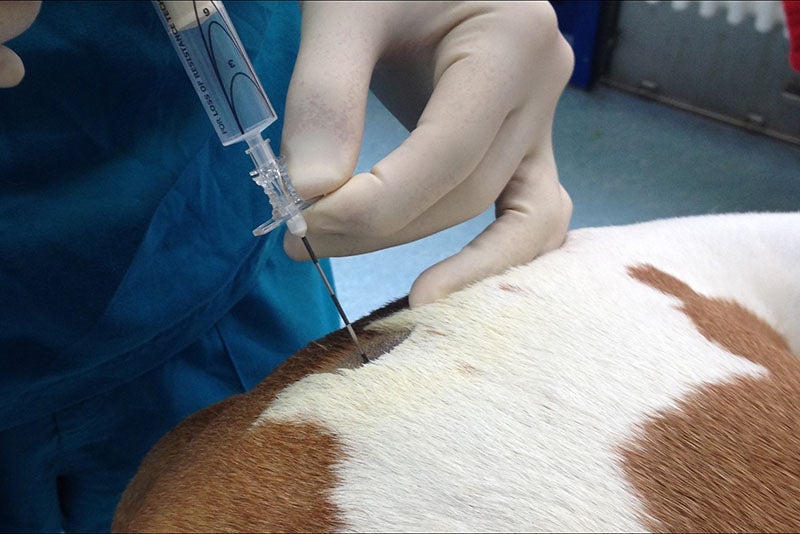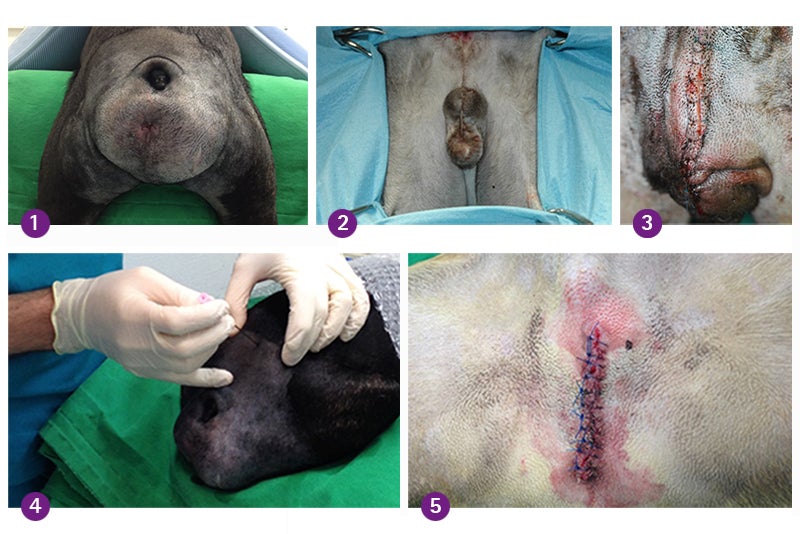Indication
Operations on pelvis, hindlimbs, perineum and abdomen
Equipment
Step by step


Local anesthetics
Epidural anesthesia L7S1
Onset of effect and duration:
Lidocain 2%: 5 min/1-2 h
Mepivacain 2%: 5-10 min/1-3 h
Bupivacain 0.5%: 10-20 min/4-6 h
Ropivacain 0.75%: 10-20 min/3-5 h
(Cruz et al. 1997, Feldman und Covino 1988, Duke et al. 2000)
Injection volumes dog (kg):
1 ml/10 kg: blockade perineum and tail
1 ml/7 kg: blockade Hglm (L3)
1 ml/5 kg: blockade caudal abdomen (L1)
0.36 ml/kg: ovariohysterectomy (T10)
(Freire et al. 2010, Almeida et al. 2007)
Injection volumes dog (Loc):
0.5 ml/10 cm: 30-35% LOC
1.0 ml/10 cm: 55-60% LOC
1.5 ml/10 cm: 70-75% LOC
(Otero et al. 2009)
Maximum volume / dog: 6ml
Injection volumes cat (kg):
0.2 ml/kg: blockade to L1/2
0.4 ml/kg: blockade to T6-10
1-1.5 ml per Cat
(Lee et al. 2004a)
Adjunktiva
Epidural anesthesia L7S1
Opioids:
Morphin (10 mg/ml)
Injection volume:
0.1 ml/10 kg
(Valverde et al. 1989a)
Alpha2 agonists:
Medetomidin (1 mg/ml)
Injection volume:
0.05 ml/10 kg
(Branson et al. 1993)
Video
-
Epidural anesthesia "hanging-drop" technique
The puncture of the ligamentum flavum and the control of the correct needle position in the epidural space can also be done with the "hanging-drop" technique.
Regional anesthesia of the hindlimb
Examples of possible applications
Regional anesthesia of the perineum
Examples of possible applications

(1) Perineal hernia (2) Perineal urethrostomy (3) Episiotomy (4) Epidural anesthesia for perineal hernia surgery (5) Castration with scrotal ablation
Regional anesthesia of the abdomen
Examples of possible applications
Advantages/Disadvantages/Contraindications
Advantages:
- Simple technique with a wide range of indications
- Postoperative analgesia in combination with morphine (up to 24 h)
- Single-shot or catheter
Disadvantages:
- Sympathic blockade (vasodilation leads to hypotension/hypothermia)
- Inefficient blockade
- Urine retention
Contraindications:
- Coagulopathy
- Hypovolemia/hypotension
- Infections or neoplasms in the puncture area
- Neuropathies
Epidural catheter
Repeatable injection:
Ropivacain 0.2% (+ Morphin)
CRI:
Ropivacain 0.2% + 2µg Fentanyl / ml admixed solution
0.02-0.05 ml/kg/h
(Otero und Campoy 2013)

Disclaimer
As with any intervention in the body, peripheral nerve blocks also carry the risk of complications. The presented procedures and dosages are thoroughly reviewed and based on currently available scientific data and clinical experience but should only be considered as guidelines along the contents of the course. The responsibility for performing the nerve blocks shown on this site as part of any anesthesia regimen or pain management lies with the executing clinician. B. Braun Vet Care GmbH and Dr. Papadopoulos cannot be held responsible for any complications or adverse effects, that may arise from the described techniques or for any mistakes in the information provided.
















